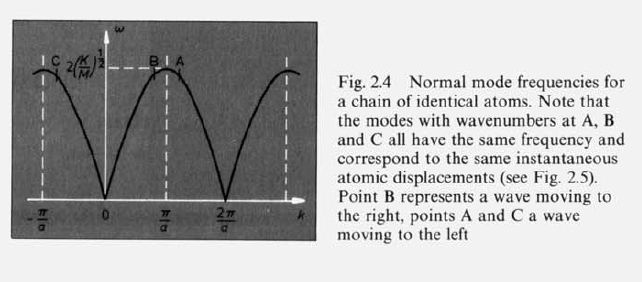Solution to Set 5: Difference between revisions
m (→Problem 1) |
|||
| Line 20: | Line 20: | ||
<math>U \cong \frac{1}{2} k \sum_{n} (U_n - U_{n-1}) \;</math> | <math>U \cong \frac{1}{2} k \sum_{n} (U_n - U_{n-1}) \;</math> | ||
<math>\Rightarrow m \ddot{ | <math>\Rightarrow m \ddot{U}_n = - k [2U_n - U_{n-1} - U_{n+1}] \;</math> | ||
Eigenvector Value | Eigenvector Value | ||
<math>u(t)=e^{i\omega t} u_n \;</math> | <math>u(t)=e^{i\omega t} u_n \;</math> | ||
<math>\Rightarrow -m \omega ^2 \vec{u} = - k \mathbf{M} \vec{u}</math> | |||
[[Image:Dispersionrelation.jpg]] | [[Image:Dispersionrelation.jpg]] | ||
Revision as of 04:19, 2 March 2009
I have no idea what I'm doing - KimberlyWynne 03:11, 2 March 2009 (EST)
Diatomic harmonic chain
Problem 1
Given:
- a chain of atoms
- with alternating masses and
- connected with elastic springs with constant
- moving only in the x-direction
Derive the dispersion relation for this chain
- Index for acoustic branch
- Index for optical branch
Potential Energy
Eigenvector Value
Problem 2
Determine the speed of sound for this chain. What is the lowest frequency of long-wavelength sound corresponding to the optical branch?
From my lecture notes:
where = speed of sound
Problem 3
Sketch the motion of the atoms corresponding to the edge of the Brillouin zone, both for the optical and the acoustic branch.
Problem 4
Determine the Debye temperature for this system, and determine the form of the specific heat in the limits of high and low temperatures.
Problem 5
Consider low temperatures () and determine the wavelength of the most abundant phonons (Hint: note the analogy with Wien's Law!)









![{\displaystyle \Rightarrow m{\ddot {U}}_{n}=-k[2U_{n}-U_{n-1}-U_{n+1}]\;}](https://wikimedia.org/api/rest_v1/media/math/render/svg/6db9a810d9ac873a2a99eb0f8607f33f37a55b22)







